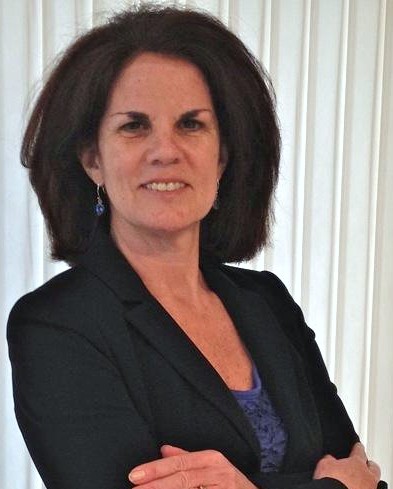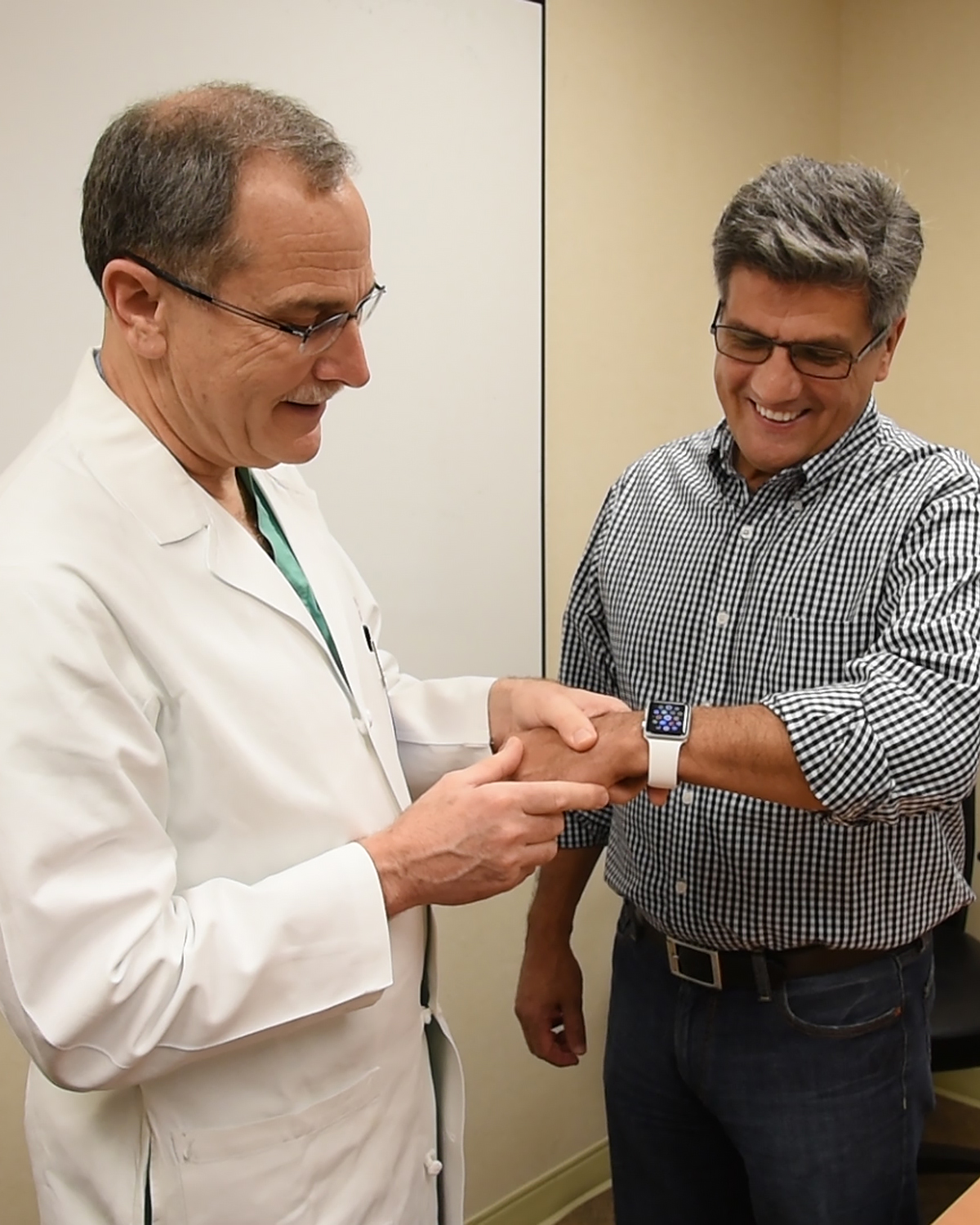 Dr. Milani with longtime patient Andres Rubiano, pilots Apple WatchDuring the last eighteen months, the Ochsner Health System has moved into new territory, meeting consumers where they are, from their OBar, a retail genius format to patient hypertension pilots with the Apple Watch to drive behavior change.
Dr. Milani with longtime patient Andres Rubiano, pilots Apple WatchDuring the last eighteen months, the Ochsner Health System has moved into new territory, meeting consumers where they are, from their OBar, a retail genius format to patient hypertension pilots with the Apple Watch to drive behavior change.
As an innovative healthcare organization, Ochsner, a large Louisiana- based health network with 12 hospitals, 40 clinicians and an a 1,000+ Physician Group Practice, is committed to helping consumers use mobile and wearable connected health tools for self- management and care collaboration
It all started back in late 2013 when Dr. Richard Milani, now Chief Clinical Transformation Officer and Vice Chair of Cardiology at Ochsner, observed what was going on nationally, a tremendous growth of mobile phone and smart apps. “At the time, I noticed that a lot of people didn’t know much about the health apps and wearables or were fearful about how to use them. My background is in preventive medicine”, explains Dr. Milani. “I saw a powerful opportunity for Ochsner to empower consumers to use mobile technology to enhance their health, opening the door to favorable behavior change.”
OBar, Retail Genuis Bar with Apps & Devices
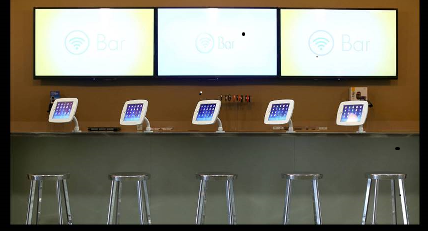 After more than nine months of planning, Ochsner launched their OBar in early 2014 at the new Ochsner Center for Primary Care and Wellness. The OBar is located in the lobby to attract people walking by as well as patients. The retail store is welcoming with digital tablets loaded with vetted mobile apps to support consumer health, “non-clinical” genius types to answer questions, provide guidance and sell discounted devices (i.e. Activity Tracker, wireless scale, blood pressure cuff and glucometer). “We created this retail setting to show people how to make themselves healthier on their own, independent of their health system. We also felt that as a health system, we could show you which health apps were good and can help you get the app loaded on your phone to begin using it.”
After more than nine months of planning, Ochsner launched their OBar in early 2014 at the new Ochsner Center for Primary Care and Wellness. The OBar is located in the lobby to attract people walking by as well as patients. The retail store is welcoming with digital tablets loaded with vetted mobile apps to support consumer health, “non-clinical” genius types to answer questions, provide guidance and sell discounted devices (i.e. Activity Tracker, wireless scale, blood pressure cuff and glucometer). “We created this retail setting to show people how to make themselves healthier on their own, independent of their health system. We also felt that as a health system, we could show you which health apps were good and can help you get the app loaded on your phone to begin using it.”
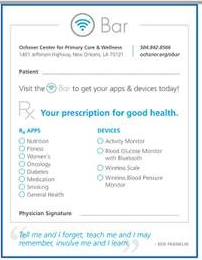 Doctor gives patient RX for App, directs to OBar Ochsner wanted to go further, tying the OBar into their primary care services. Dr. Milani and his team created a prescription pad for their PCP offices, which lists the types of available apps and devices. The doctor simply checks off, hands the patient a prescription pad sheet and directs him downstairs to the OBar. Since this extension into primary care, clinicians have heard back from their patients about how the apps and devices have helped them make better health choices around activity, diet and their disease. Patient feedback has motivated these clinicians to tell others about the OBar.
Doctor gives patient RX for App, directs to OBar Ochsner wanted to go further, tying the OBar into their primary care services. Dr. Milani and his team created a prescription pad for their PCP offices, which lists the types of available apps and devices. The doctor simply checks off, hands the patient a prescription pad sheet and directs him downstairs to the OBar. Since this extension into primary care, clinicians have heard back from their patients about how the apps and devices have helped them make better health choices around activity, diet and their disease. Patient feedback has motivated these clinicians to tell others about the OBar.
Dr. Milani went on to explain that the OBar initiative is not designed to be a profit center. As a non-profit, Ochsner is most interested in helping people stay healthy and has invested in a retail format as a way to be sticky to attract and keep consumers coming back. As with any retail store, visitors walk in and out which makes it challenging to capture and measure the value that consumers have gained from using these apps and devices. Through anecdotes, however, Ochsner has heard about the weight loss, the knowledge about “buying the right foods” and the ability to better “understand my disease”, which has helped many consumers visiting the OBar.
Apple HealthKit & Epic Integration for Connected Health
Ochsner was the first hospital to integrate the Apple HealthKit with their Epic system. This integration powers their Connected Health programs. While the patient is still in the hospital, she is given a tablet to answer a detailed questionnaire. Hypertensive patients, for example, are asked sodium consumption, medication adherence and affordability, social situations, depression, physical activity, BMI, sleep, Health literacy, Patient activation and more. Ochsner believes that patients respond more truthfully to the tablet.
“We are phenotyping patients based on their specific disease and psycho- social measures that are fed into algorithms to personalize the care plan and decision support tools”, Dr. Milani explains. “Ochsner started with Heart Failure in early 2014, with a program for CHF patients to avoid readmissions through weight monitoring. In February 2015, we launched our Hypertension Digital Medicine Program, monitoring blood pressure and heart rate. “With the HealthKit/Epic integration, we are able to use the patient’s unique responses to the survey combined with the monitoring data to tailor the intervention to the individual”, adds Dr. Milani. Ochsner care providers monitor the dashboard to determine which patients are the priority today and to see the task check list for action.
The national data reflects that currently, only 50% of individuals diagnosed with hypertension (high blood pressure) have their blood pressure under control, or at goal. Lack of achieving goal blood pressure means that these individuals have significantly higher rates of stroke, heart disease and kidney failure. Ochsner has enrolled only patients that have failed to meet control blood pressure goals, and using this integrative approach, has achieved more than 60% control rates within 2 months.
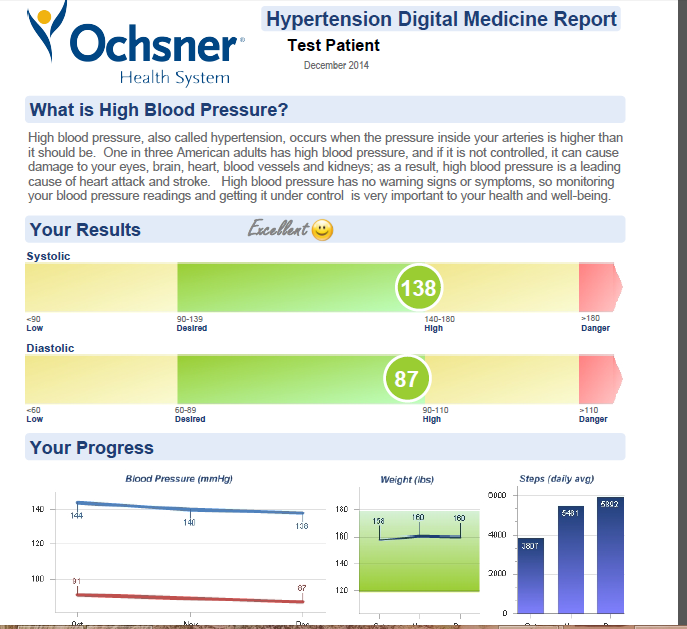 Dr. Milani and his team wanted the patient to see his progress in the program and designed an insightful report, which visually displays results and progress, quantifies risk and describes how the patient can reduce that risk. This program report is available in the patient portal and is also mailed monthly to the patient. “We decided to mail the report because we wanted the patient to have the opportunity to share the report with their family and to have the discussion about how they are doing in controlling their blood pressure in order to strengthen every day support”, admits Dr. Milani.
Dr. Milani and his team wanted the patient to see his progress in the program and designed an insightful report, which visually displays results and progress, quantifies risk and describes how the patient can reduce that risk. This program report is available in the patient portal and is also mailed monthly to the patient. “We decided to mail the report because we wanted the patient to have the opportunity to share the report with their family and to have the discussion about how they are doing in controlling their blood pressure in order to strengthen every day support”, admits Dr. Milani.
In addition to the program report, program participants receive ongoing mobile texts for motivation and encouragement.
Ochsner closely tracks, monitors and has presented very positive patient outcomes of their Integrated & Connected Health programs. One interesting insight that Dr. Milani has shared is that these participants are more successful in the beginning when they have the OBar support. “A Hypertensive patient can go to our OBar, get the program app downloaded on her phone and a demonstration about how to use the devices. This is especially important with older patients who may not feel comfortable getting set up over the phone. We realize the importance of providing this face to face technology support for our Connected Health program and are adding OBars to our other regions”, confirms Dr. Milani. Ochsner is planning to launch three more retail OBars by the end of the year.
Apple Watch for Patient Pilot
Dr. Milani views the Apple Watch as a behavioral change tool. As a foundation, this is a wearable, with many non-health features which captures the consumer’s attention and motivates consumer engagement. It takes the consumer’s focus off the phone and onto the wrist to communicate time as well as personal and professional messages.
Ochsner is designing a study to understand the potential for changing the consumer’s behavior around health. They will be enrolling hundreds of hypertensive patients with the goal of increasing physician activity and improving medication adherence.
Dr. Milani mentioned two of the health related Apple Watch apps which he plans to incorporate to help patients achieve the pilot goals. “There is a WebMD app which is a great medication reminder. It taps you on your wrist and shows you the picture of the pill that you need to take at that time. This is important because 50% of patients with chronic disease do not take their medications as prescribed. The second built-in app is for physical activity which can be used to set goals. It will tap me and remind me to stand up every 50 minutes. I can also see how I am doing against my activity goals”, shares Dr. Milani.
For the Apple Watch pilot, Ochsner will compare the outcomes and behavior change for patients in their Hypertension Digital Medicine Program with a subset of patients who also have the Apple Watch medication and activity reminders and tracking. Throughout the pilot, Dr. Milani and his team will be closely monitoring whether and how these apps impact positive patient behavior change.
 Permalink
Permalink  chronic care management,
chronic care management,  educating consumers about health and wellness,
educating consumers about health and wellness,  health coaching,
health coaching,  mobile health application,
mobile health application,  patient generated health data in
patient generated health data in  Connected Health,
Connected Health,  Data Driven Health Engagement,
Data Driven Health Engagement,  Mobile Health,
Mobile Health,  Patient Decision Support,
Patient Decision Support,  Patient Engagement,
Patient Engagement,  Patient Experience,
Patient Experience,  Patient Journey,
Patient Journey,  TeleHealth,
TeleHealth,  TeleMedicine,
TeleMedicine,  digital health,
digital health,  patient health education
patient health education 
